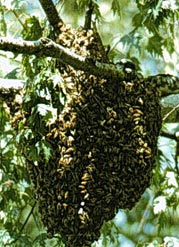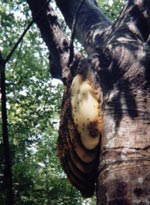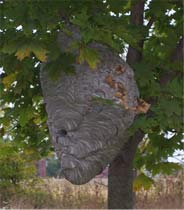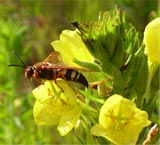Main Content
Article
Indiana Honey Bee Swarms

Honey Bee Swarm
The photo to the right is a honey bee swarm. The bees are clustered together waiting to move into a permanent home. If what you are looking at does not look like this photo, please refer to the “honey bee nest or wasp nests” information below.
When you see a swarm, do not panic. A swarm of honey bees is generally very calm and they rarely sting. Do not spray the swarm with water or poison. Call a beekeeper as soon as you see them.
Why do honey bees swarm?
There are many reasons why honey bees swarm. It's the natural method or reproduction or increase in population. Most of the time, it's because a beekeeper’s hive is overcrowded and the queen has run out of space to lay eggs. She will stop laying eggs and shrink down in size so she can fly. When swarming, the queen takes off with part of population to start a new colony. The old colony will make a new queen and continue to prosper.
The swarm will fly away, land and cluster on a tree limb, brush or other location. The swarm cluster may be the size of a softball to larger than a basketball. Normally, this is not a permanent home and they usually move onto a preferred home such as a hollow tree.
Swarm season in Indiana is in May around Mother's Day. Once in while, there may be swarms in March and into September. This depends on the weather and the hive condition.

Exposed Honey Bee Nest
Beekeepers do try to prevent swarming. Usually if the hive swarms, the beekeeper will not get as much honey from that hive.
Swarms after July 1 are late swarms that may not make it through the winter unless the beekeeper does several things to get them strong enough for the winter.
A honey bees' preferred home is a hollow tree where they will be protected from the cold weather. Once in a while, they will start a new home in an exposed tree limb. In this situation, you will see the exposed yellow beeswax comb that the bees will be clustering on. Sadly, they will not make it through Indiana’s winters. If you do see this comb and bees, contact a beekeeper.
Occasionally, a hollow tree with bees in it may need to be cut down. Contact a beekeeper to see if they are interested. Some beekeepers will come and get these bees.
If you have honey bees in a home or building, the comb needs to be removed as well as the bees. This can be tricky and not all beekeepers will take bees out of buildings. For one thing, they either have to take down siding or drywall to get to the bees and comb making this a difficult job. If you can not get a beekeeper to assist, then you will need to hire an exterminator to kill the bees. Later, you will have to remove the comb and dead bees.

Paper Wasp Nest
Honey bee nests or wasp nests
Honey bee nests are made out of beeswax that the bees produce. Wasp or hornets make their nest out of paper. They will chew on wood and take that back to the nest to use in making their nest. The nest starts out small in the spring and is being worked on throughout the summer into the fall. Some nest can get bigger than a basketball by September.
If the nest is more the 10 feet high in a tree, it can be left alone. Lower nests can be left alone if not a hazard to people or pets. If they are a hazard, it is up to the landowner to take care of the nest. They can call an exterminator or try an over-the-counter pesticide such as hornet wasp spray in a can. If you use an over-the-counter pesticide, follow the label closely. Spray at dusk when you can still see without using a flash light. Soak the nest with pesticide. Leave it alone after you spray it and check it the next day. If you see activity, spray it again. When you see no more activity, it may be safe to cut down, close up in a plastic bag and dispose of properly.

Eastern Cicada Killer
Not all wasps or hornets make nests. Most are solitary wasps, meaning each wasp is on its own to mate, reproduce and find food for their young. Example here in Indiana would be the Eastern Cicada Killer.
